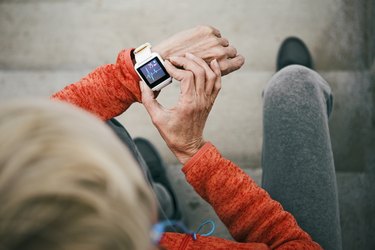
Have a goal number you're trying to reach on the scale? Then it's worth paying attention to your target heart rate for weight loss.
Sometimes called the fat-burning heart rate, your target heart rate is basically the number of times your heart should beat a minute during exercise to ensure that you're burning enough calories, as well as working hard enough to keep your ticker in good shape.
Video of the Day
Video of the Day
So what kind of numbers should you be aiming for — and how can you tell if you're on the right track? Here's everything you should know.
What Is the Fat-Burning Zone?
Your target heart rate is a number that shows your heart is working hard enough — and that you're burning a worthwhile number of calories — during exercise.
A person's specific target heart rate depends on his or her age: The older you are, the lower your target should be. But generally, it should be between 50 to 85 percent of your maximum heart rate (MHR), according to the American Heart Association (AHA).
Calculate Your Maximum Heart Rate
Get the formula here, plus a handy chart that breaks down average MHR by age.
Is there a certain target heart rate that encourages your body to burn more fat? The simple answer is yes.
Exercising at around 70 percent of your MHR will encourage your body to use more energy from fat, while exercising at a higher heart rate will encourage your body to use more energy from carbohydrates, according to a February 2011 review published in the journal Clinical Nutrition Espen.
Staying in the so-called fat-burning zone might seem like the best option if you're looking to lose weight. But in fact, that's not necessarily the case.
What’s the Best Heart Rate for Weight Loss?
Maintaining a target heart rate somewhere between 50 and 85 percent of your MHR during exercise is the ideal for weight loss. But sticking with a higher percentage means you're working harder, which ultimately burns more calories, according to Johns Hopkins Medicine.
But what about that 70-percent target heart rate that supposedly keeps you in the fat-burning zone?
In truth it doesn't matter whether your body burns calories from fat or carbohydrates during exercise. What matters is that you burn calories, period. And you'll actually burn more calories when you exercise at a more vigorous intensity with a higher heart rate, according to the Mayo Clinic.
Ultimately, "you're always burning a mixture of carbs and fat," explains Cathy Richards, ACSM-certified exercise physiologist. "If you are working extremely hard, you would be able to burn a very high number of total calories per minute."
That's not to say you have to go all-out the entire time for every single sweat session in order to lose weight. Far from it.
"I'm a fan of using anywhere within 60 to 85 percent max heart rate for as long as you can go and mixing things up. Some days you could do lower intensity for longer and other days you could do higher intensity for shorter," Richards says.
Getting the Right Heart Rate for Your Workouts
If you're aiming to exercise at a moderate pace, you should aim for a target heart rate that's 50 to 70 percent of your MHR, according to the AHA. Want to stick to a vigorous pace? Your target heart rate should be between 70 and 85 percent of your MHR.
Figuring out your individual target heart rate for exercise requires a little bit of math. You'll start by determining your maximum heart rate, which you can figure out by subtracting your age from 220. If you're 35 years old, for instance, your maximum heart rate would be 185.
To figure out your target heart rate for exercise, take your MHR and multiply it by the percentage you want to aim for while working out. If you're a 35-year-old who wants to exercise at 70 percent of your MHR, you'd multiply 185 by .7 to get a target heart rate of about 129 beats per minute.

Workouts That Get You in the Zone
Which types of exercise will help you achieve your target heart rate so you can torch serious calories and get closer to your weight-loss goals? You've got plenty of options, according to the Harvard T.H. Chan School of Public Health:
Moderate exercise: 50 to 70 percent of your MHR
- Walking at 4 mph
- Bicycling at 10 mph
- Playing tennis doubles
- Heavy cleaning (like vacuuming or washing windows)
- Playing badminton
Vigorous exercise: 70 to 85 percent of your MHR
- Jogging at 6 mph
- Bicycling at 14 mph
- Hiking
- Playing tennis singles
- Playing soccer or basketball
Either a moderate- or vigorous-intensity workout will lead to calorie burn. But since vigorous workouts are harder, they enable you to burn more calories in less time. You can burn a lot of calories at a moderate pace too — you'll just need to extend the length of your workout, Richards says.
For instance, a 150-pound person will burn around 660 calories jogging at a fairly vigorous pace of 5.5 mph for an hour. To burn the same number of calories walking at a moderate pace, the person would need to walk for close to two hours, according to the AHA.
Tools for Monitoring Your Heart Rate
Now that you know the heart rate to aim for and the activities that'll help you achieve it, make sure you're staying on track. Keeping your heart rate in your desired zone will help you burn the number of calories you're aiming for so you can reach your weight-loss goals faster.
To check your target heart rate during exercise, you've got a few different options. For real-time feedback, consider using an activity tracker watch or a chest monitor. Both devices track your pulse, so they're an easy way to tell if you're in the zone.
Check Out Our Top Picks
"I've found better consistency and connectivity with chest monitors, which translates into more consistent and accurate heart rate reporting," Richards says.
Of course, not everyone likes working out with a monitor strapped to his or her chest. "A watch might be better for some people who feel it's too annoying, uncomfortable or cumbersome to use a chest monitor," she says.
Just keep in mind that neither device is foolproof. Wearable trackers can give you a ballpark estimate of your heart rate, but you can't count on them to be precise, per the Mayo Clinic.
The good news is that most casual exercisers don't need intense precision when it comes to tracking their heart rate.
"I'm a fan of keeping it simple," Richards says. That means paying attention to how you feel:
- Moderate pace: Your breathing is faster than normal but you're not out of breath, and you can carry on a conversation but you can't sing
- Vigorous pace: Your breathing is fast and heavy and you shouldn't be able to say more than a few words without taking a pause
At any point during a workout, you can pause to check in with your body and see if you're on pace. If it seems like you're working harder than you'd like, slow down. And if you don't feel like you're working hard enough, push yourself a little more.
Ready to Lose Weight?
Set yourself up for success with LIVESTRONG.com's 30-Day Weight-Loss Kickstart.
- American Council on Exercise: "Advances in Aerobic Training: How to Apply the New Heart Rate Formulas"
- American Heart Association: "Know Your Target Heart Rates for Exercise, Losing Weight and Health"
- University of New Mexico: "Fat Facts"
- Harvard Health Publishing: "Feel the Beat of Heart Rate Training"
- Health.gov: "Physical Activity Guidelines for Americans"